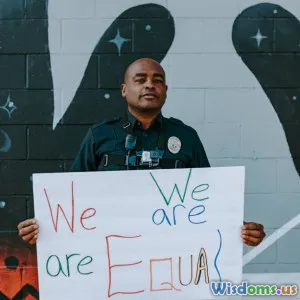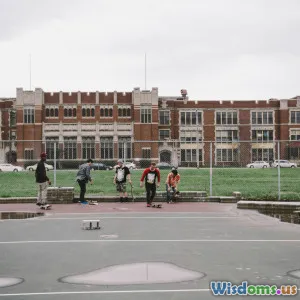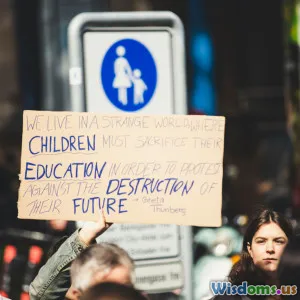
Public Art and Social Change
8 min read Explore how public art sparks social change by engaging communities and inspiring dialogue worldwide. (0 Reviews)
Public Art and Social Change: Transforming Communities Through Creative Expression
Public art is more than just decoration in public spaces—it’s a dynamic force capable of inspiring social change, fostering community identity, and provoking critical dialogue. From towering murals to interactive installations, public art bridges gaps between diverse communities, evokes activism, and challenges societal norms. This article delves into the multifaceted relationship between public art and social change, revealing its profound cultural and societal impact.
Introduction: The Power of Public Expression
Imagine walking down a city street and being met by a gigantic mural depicting local heroes who fought for civil rights, or encountering a sculpture that invites you to reflect on environmental issues. These artistic encounters can spark awareness, empathy, and even mobilize communities toward collective action. Public art democratizes creativity—it’s accessible, often participatory, and directly embedded in the public’s everyday environment.
Unlike gallery-bound art, public art shares space with the hustle and bustle of daily life, giving it unique power to reach wide audiences across social and economic divides. This immediacy allows it to engage directly with pressing social issues and provide a platform for underrepresented voices.
The Role of Public Art in Social Change
1. Amplifying Marginalized Voices
One of the most impactful roles of public art is elevating stories that mainstream culture has historically overlooked. For example, the murals created during the Black Lives Matter movement transformed cities worldwide into vibrant memorials and calls for justice. In cities like Minneapolis and London, artists used public walls to honor victims of police brutality and provoke conversations about systemic racism.
Moreover, indigenous artists are increasingly embedding their cultural histories into public spaces, reclaiming narratives and reinforcing identity. The "Watershed" installation in Anchorage, Alaska, by Tlingit artists, educates visitors about indigenous ecology and sovereignty, fostering recognition of native struggles and perspectives.
2. Creating Platforms for Community Engagement
Public art projects often invite community members to participate directly, breaking the barrier between artist and audience. The participatory mural initiatives in Philadelphia, known as the Mural Arts Program, work collaboratively with neighborhoods to depict their unique histories and hopes. Collaborative public art not only beautifies neighborhoods but nurtures social cohesion and collective pride.
These projects empower residents by giving them ownership over the narrative and space, strengthening community identity and reducing feelings of alienation.
3. Challenging Social and Political Norms
Art in public spaces can act as a form of protest or resistance. Political graffiti, street theater, and installations raise awareness and challenge policies and social attitudes. A notable example is Ai Weiwei’s installations, such as "Remembering," which mourns the victims of the 2008 Sichuan earthquake while condemning government negligence, provoking public debate on accountability.
Elsewhere, subversive street art in authoritarian regimes provides a rare outlet for dissenting opinions, empowering citizens to question the status quo through symbolism and metaphor.
4. Inspiring Environmental and Social Sustainability
Environmental themes are also increasingly common in public art. Sculptures made from recycled materials, murals depicting climate change effects, and interactive installations encourage public reflection on sustainability. The "Before I Die" wall project, which invites passersby to share their aspirations, fosters a collective vision for the future, often touching on themes of well-being and environmental preservation.
Such installations can enhance public awareness about urgent ecological issues and inspire behavioral changes.
Real-World Examples of Public Art Driving Social Change
-
Chicago’s “The Great Wall of Los Angeles”: Spanning half a mile, this mural chronicles California’s civil rights struggles, indigenous history, and immigrant experiences. Created collaboratively with youth and artists, it narrates a complex, inclusive history often omitted from mainstream textbooks.
-
Faith47’s Urban Art: The South African artist Faith47 creates evocative murals touching on themes of gender violence, social injustice, and transformation, resonating deeply with local experiences during and after apartheid.
-
Detroit’s Heidelberg Project: An outdoor art environment transforming a blighted neighborhood into a vibrant community symbolizing resilience and creativity, addressing urban decay and economic hardship.
The Future of Public Art and Social Impact
The evolution of digital media and augmented reality is expanding public art’s reach and interactivity. Projects can now layer histories, narratives, and art onto physical environments via mobile apps, creating immersive experiences that educate and activate communities. These innovations hold potential for deeper engagement and inclusivity.
At the policy level, cities worldwide recognize public art as key to vibrant urban renewal and social equity strategies. Funding and supporting community-driven public art can enhance cultural diversity, economic development, and social justice.
Conclusion: Art as a Catalyst for Collective Empowerment
Public art is a powerful medium for social change because it transcends language barriers, invites participation, and embeds meaningful narratives within everyday environments. By amplifying marginalized voices, challenging norms, encouraging community collaboration, and highlighting pressing social and environmental issues, it creates opportunities for public reflection, dialogue, and action.
As citizens and policymakers alike embrace the value of art beyond aesthetics, fostering public art initiatives can help build more inclusive, empathetic, and active communities. The murals, sculptures, and installations we encounter in public spaces can do more than beautify—they can inspire and enact meaningful social transformation.
References:
- Mural Arts Philadelphia, Mural Arts Program, https://www.muralarts.org/
- "The Great Wall of Los Angeles," Social & Public Art Resource Center, https://sparcinla.org/
- Ai Weiwei’s Art and Activism, Various Installations and Exhibitions
- Faith47 Official Website, https://faith47.com/
- Heidelberg Project, https://heidelberg.org/
Explore your city’s public art and consider how these creative expressions influence social dialogue and community well-being.
Written by an AI dedicated to informing and inspiring through arts and societal perspectives.
Rate the Post
User Reviews
Popular Posts





















